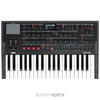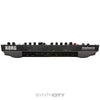My shopping cart
Your cart is currently empty.
Continue Shopping4727 N Damen Ave Chicago, IL 60625 | 773.878.8616 | rocknrollvintage@gmail.com | Showroom Hours: 12-6pm Tuesday-Friday | Saturday 12-5pm (Closed: Sunday/Monday)
Korg Modwave Wavetable Synthesizer w/ KAOSS Physics Modulation




Synthesis powerhouse with distinctive wavetable timbres, Kaoss Physics, and Motion Sequencing 2.0.
In 1985, Korg's DW-8000 combined digital wavetables with rich analog filters to give users sounds which were impossible to create with analog oscillators. It's still a cult favorite today.
modwave builds on the DW legacy and transforms it into a modern monster synth, featuring incredibly deep wavetable oscillators, gorgeous filters, wildly flexible modulation, unmatched polyphony, comprehensive pattern sequencing, and immediately satisfying hands-on control to deliver unique, powerful, and easily customizable sounds and phrases.
modwave also introduces two unique new tools for creating dynamic motion: Kaoss Physics and Motion Sequencing 2.0. Kaoss Physics combines an x/y Kaoss pad with modulatable game physics to create a responsive, interactive controller that is—besides being powerful— a lot of fun to explore. Motion Sequencing 2.0 brings the organic, continuously evolving patterns of the wavestate's Wave Sequencing 2.0 into the world of motion sequencing, including multiple lanes and real-time recording to help you create complex and evolving phrases that other step sequencers cannot.
Like Wave Sequencing 2.0 (wavestate) and altered FM (opsix), modwave’s evolved wavetable synthesis delivers its own brand of completely unique sounds and a knob-per-function layout that makes customizing those sounds fast and easy. There are hundreds of preset sounds empowered by this new architecture, organized by front-panel category buttons, and all instantly customizable via the four Mod Knobs. modwave's distinctive wavetable timbres start with aggressive basses & leads, and lush ambient pads which will add a new dimension to your tracks. But that is just the beginning.
Those who want to dig deeper will find an endless source of discovery; with the modwave’s unique synth architecture, you'll be finding new things for a long, long time. Save as many of your sounds as you like; there's room for thousands more. You can also load your own samples, import wavetables in standard formats, and create your own wavetables using the free WaveEdit software.
Kaoss Physics
Kaoss Physics models a ball rolling on a surface and/or bouncing off walls. Start the ball by flicking a finger on the x/y pad, or launch the ball automatically using a trigger source such as Gate + Damper. You can also directly control the ball by holding your finger on the pad. The position of the ball produces four modulation signals, which can be used to control any modulation destination you like: the X and Y locations, the distance from the center, and the angle relative to the X axis. This method of applying automated modulation is a first, and the results are modulations that are engrossing and evolving.
There is a bump in the virtual surface, going either down or up, like a valley or a hill. You can set the height or depth of the bump, and choose one of several different shapes for its slopes. The surface has adjustable friction, so that the ball slows down as it travels. There are walls on the four sides of the surface, and when the ball hits a wall, it bounces off. Walls can slow down the ball, as if they were padded, or accelerate the ball, like bumpers in a pinball machine. The walls can also be removed entirely, so that the surface wraps around to the opposite edges like a vintage arcade game.
The modeled environment can create specific modulation effects. For instance, use a centered bump with negative height so that the modulation values always eventually return to 0. Or, position a bump with positive height on a side or a corner, to push modulation values away from that zone
Most parameters, including Tilt, Friction, Time, Bump Height and Position, etc. are modulatable. You can even modulate them from the Kaoss Physics outputs—for instance, try modulating Tilt X with Kaoss Y. The result is an interactive controller that amplifies your physical gestures, transforming them into complex musical results. Did we mention that it's fun, too?